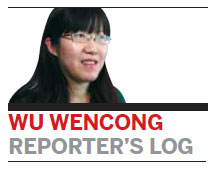Two sessions: a test and a feast for reporters
Updated: 2013-03-13 07:12
By Wu Wencong (China Daily)
|
||||||||

Being in an occupation that abounds with night owls, getting up before 6 am for more than 10 consecutive days is already quite a challenge. But this is just the beginning for reporters covering the annual sessions of the National People's Congress and the Chinese People's Political Consultative Conference.
The end of a working day for NPC deputies and CPPCC members is marked by the conclusion of the daily group discussion or a plenary session, usually at around 5 pm, but reporters still have to organize interviews from throughout the day and write stories for the next day's paper.
Less than three days after the start of the sessions, the faces of reporters covering the two sessions are marked with obvious fatigue. One colleague was once so tired that he even missed his stop when taking the subway home after 11 pm.
We reporters are no strangers to fatigue, and events like the two sessions, which include about 5,000 top officials and scientists nationwide, are certainly worth being worn out for. I've heard that such events can best test the survival capabilities of a journalist. As I see it, the toughest trial is on one's vision.
Certainly, it is impossible to know all the deputies and members attending the sessions. But if you can clearly see their name tags, immediately Googling them with your iPhones isn't too hard a job. After all, you have to know who you are speaking with before asking any questions.
As a nearsighted greenhorn, I spent several days before the sessions searching for photos and biographies of selected CPPCC members from the 120 in the group I cover so that I can spot these "big potatoes" and get my questions in before they slip away.
My preparation attracted the admiration of other reporters, and some even eagerly asked me where to fetch such useful material.
But I soon discovered that I might not be rewarded for this because most CPPCC members look similar: stout, middle-aged men in their 50s or 60s wearing suits that look the same to me. Most importantly, some only have photos on the Internet from 10 or even 20 years ago.
Intentional or not, the working groups for the two sessions have also set some barriers for reporters, such as not setting out name tags during the top political advisers' panel discussions, making it hard to tell who is speaking and preventing reporters from getting into the meeting rooms before the discussions start.
But of course I was prepared for this. I had been tipped by an experienced journalist that the best time for an interview is in the corridor when the deputies and members head for the bathroom. At the end of the first day's panel discussion, I realized that the experienced journalist must never have been to the hotel I was covering, since the bathroom is so close to the meeting rooms that the CPPCC members may get there without even touching the corridor floor!
Though exhausted and encountering all kinds of barriers, I surprisingly found myself getting more mentally excited as the two sessions proceeded.
During a consultative meeting about pollution control, top officials from the ministries of environmental protection, water resources, housing and urban-rural development, and land and resources answered questions raised by dozens of CPPCC members from their own perspectives, getting right down to the problems with no political claptrap.
Liu Bingjiang, head of the Total Pollutants Control Department at the Environmental Protection Ministry, commented that the deteriorating environment is partly the result of weak enforcement of laws and the low cost of breaking them.
Scientific elites disclosed figures that were still new to the public. For example, Qin Dahe, a CPPCC member and former head of the China Meteorological Administration, said the China Meteorological Administration set up four global atmospheric background monitoring stations in the 1990s as required by the World Meteorological Organization. The reading of fine particles from a station in Qinghai province was between 70 to 80 micrograms per cubic meter at that time, about four times the world average.
He said the reading was already high, even without human activity in that region and called for public attention to distinguish fine particles that are generated by natural processes and by human emissions.
The two-and-a-half-hour conference was filled with high-quality discussions and loads of interesting figures about environmental protection that made environmental reporters such as me so excited that I couldn't fall asleep until 2 am.
With all the elites and top officials gathered together, the two sessions are a feast for reporters where pain comes with joy.
Contact the writer at wuwencong@chinadaily.com.cn
(China Daily 03/13/2013 page8)

 In Photos: 7.0-magnitude quake hits Sichuan
In Photos: 7.0-magnitude quake hits Sichuan
 Li Na on Time cover, makes influential 100 list
Li Na on Time cover, makes influential 100 list
 FBI releases photos of 2 Boston bombings suspects
FBI releases photos of 2 Boston bombings suspects
 World's wackiest hairstyles
World's wackiest hairstyles
 Sandstorms strike Northwest China
Sandstorms strike Northwest China
 Never-seen photos of Madonna on display
Never-seen photos of Madonna on display
 H7N9 outbreak linked to waterfowl migration
H7N9 outbreak linked to waterfowl migration
 Dozens feared dead in Texas plant blast
Dozens feared dead in Texas plant blast
Most Viewed
Editor's Picks

|

|

|

|

|

|
Today's Top News
Live report: 7.0-magnitude quake hits Sichuan, heavy casualties feared
Boston suspect cornered on boat
Cross-talk artist helps to spread the word
'Green' awareness levels drop in Beijing
Palace Museum spruces up
First couple on Time's list of most influential
H7N9 flu transmission studied
Trading channels 'need to broaden'
US Weekly

|

|







